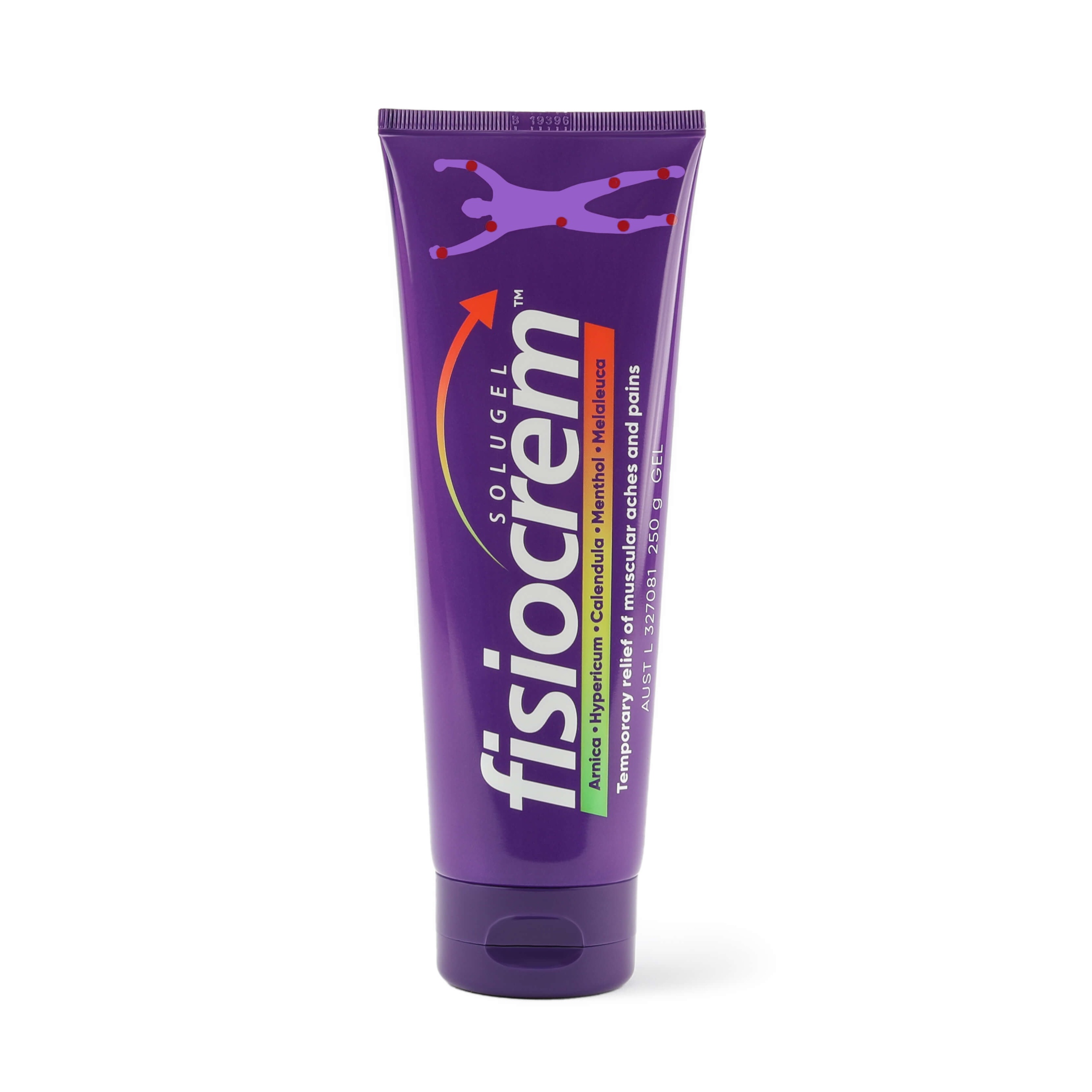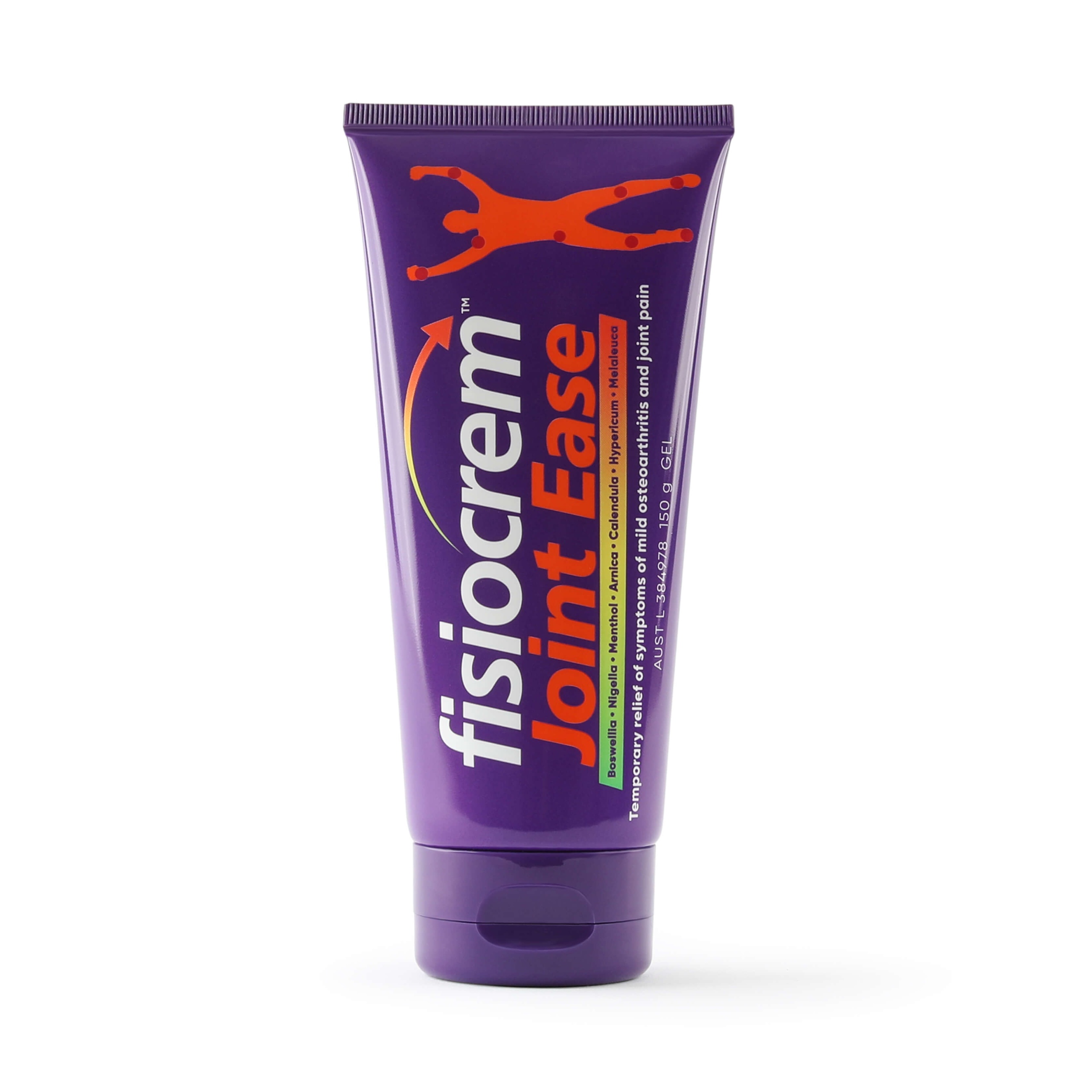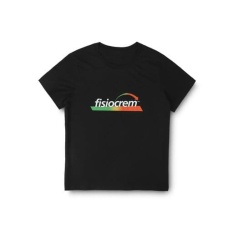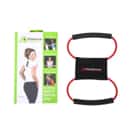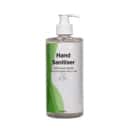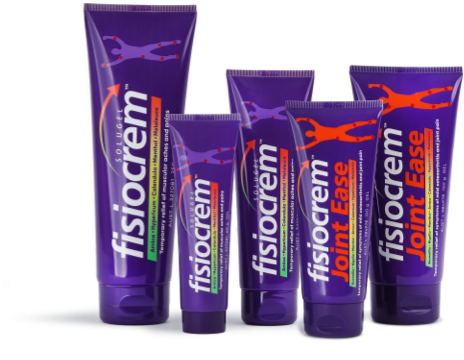Introducing fisiocrem sponsored athlete Maddi, an all-round athlete who enjoys competing in multiple fitness challenges, including HYROX (Hybrid fitness racing).
Maddi’s favourite activity will always be running, a pursuit she consistently returns to. However, she has fallen into the world of HYROX – which still encourages her to maintain her base running while also focusing a bit more on the strength components of training. She says, “it still encourages me to keep up my base running.”
When looking at her accomplishments, Maddi mentioned that her top two achievements so far are the 2022 Surf Coast Century 50km and the 2023 Sydney HYROX. These achievements stand out for their distinct nature. The Ultra involves extended time on her feet and testing physical endurance, while HYROX presents a comprehensive full-body challenge. Maddi believes that for both of those accomplishments, her approach was quite similar, focusing on dedicating time to her legs and body, getting acquainted with the demands on her physique, and maintaining a consistent training routine.
After a year of intense running, Maddi made the decision to scale down her running activities and introduce some HYROX events into her training regimen. Maddi stated, “I knew I was going to reduce my running distance and alter my training in 2023.” She is gearing up for an ambitious 2024, adding even more HYROX events into the mix.
Maddi’s biggest supporter is her partner, Jarryd. She says “As parents, it’s always been a bit of a juggling act with the kids. Family time is really important to us, but so is taking time for ourselves to do what we love. I definitely wouldn’t be able to do what I do without him!”. Whenever Maddi is at the gym or out on the trails, her partner is either taking care of the children or standing at the finish line, offering enthusiastic support. On days when she lacks motivation to lace up her running shoes, he encourages her by emphasising the post-run satisfaction. Maddi acknowledges that she couldn’t achieve her goals without his unwavering support and encouragement. Maddi firmly believes that there’s nothing more gratifying or inspiring than witnessing someone achieve a goal they’ve diligently pursued.
MADDI’S TOP RECOVERY TIPS
Maddi’s foremost advice on recovery is to heed your body’s signals. She says, “You know your body better than anyone else and it will tell you when it needs a little bit more TLC.”
"Witnessing someone achieve a goal is truly satisfying."
Maddi Wilde
If you’ve ever experienced the discomfort of a stiff neck, you know just how challenging it can be to find neck pain relief. That nagging pain and limited mobility can affect your daily life in many ways. Individuals may experience difficulties with general activities, such as turning their heads or driving a car. This article discusses neck pain, including symptoms, causes, treatment, and remedies to help relieve a stiff neck and pain.
Understanding Neck Pain
Neck pain is a common problem worldwide, especially in women (Côté et al., 2003)(Bovin et al., 1994). Neck pain affects people, their families, communities, businesses, and the healthcare system significantly. A variety of environmental and personal factors can influence the onset of neck pain (Hoy et al., 2010). Studies have found that there is a higher incidence found in office and computer workers (Hoy et al., 2010).
Neck pain and Stiffness: Symptoms and Causes
Neck pain can manifest in several ways, and its causes can be diverse. Common symptoms of neck pain include:
- A dull or sharp pain in the neck area
- Stiffness, limiting your range of motion (ROM)
- Difficulty turning your head
- Muscle stiffness
- Headaches
The causes of neck pain can vary from person to person and may include:
- Poor posture and poor ergonomics
- Muscle strain or tension
- Trauma or injury (Medical Clinics, 2012)
- Nerve compression
- Degenerative conditions (Medical Clinics, 2012)
- Age (Evans, 2014).
- Work-related stress and risk factors (Evans, 2014)(Ariëns et al, 2000)
How to Get Rid of a Stiff Neck
When faced with a stiff neck, the urgency for relief becomes paramount. Here are some practical tips that can help you eliminate that discomfort and enhance your overall well-being.
1. Heat and Cold Therapy
Applying either a hot or cold pack to the affected area can treat neck strains. Applying a heating or cold pack to the neck for 30 minutes can help relieve acute neck pain (Garra et al, 2010).
Heat pads, self-applied can assist in effectively relieving pain and improve range of motion (Cramer et al., 2012). You can use a hot water bottle or wheat pack to apply heat to the area.
Cold pack treatments can help to reduce inflammation. You can use ice packs, ice towels or even a pack of frozen peas (William, et al., 2013).
2. Gentle Neck Stretches & strengthening exercises (Cohen, 2015).
Regular stretching & strengthening exercises can help reduce neck and shoulder pain (Louw et al., 2017). Stretching regularly can improve neck movement and quality of life for people with neck pain and stiffness (Tunwattanapong et al., 2015). Performing gentle neck stretches can help relieve tension, improve flexibility and strengthen the muscles, preventing future stiffness.
Some effective stretches include neck tilts, head turns, shoulder rolls, neck rotations and chin tucks. Remember to do these exercises slowly and without force to avoid further strain.
3. Over-the-Counter Pain Relievers
Non-prescription pain relievers like ibuprofen can provide temporary relief from neck pain and reduce inflammation. However, it’s essential to follow the recommended dosage and consult a healthcare professional if needed.
4. Neck Support Pillows
The use of spring and rubber pillows can help to reduce neck pain (Pang et al., 2021). Investing in a supportive pillow can make a significant difference in preventing and relieving neck pain. A pillow designed to support your neck’s natural curve can help maintain proper alignment while you sleep.
5. Muscle Pain Relief Gel
Another way to soothe a stiff neck is by using a muscle pain relief gel. Creams with anti-inflammatory properties can relieve pain and reduce muscle tension in the affected area (Medical Clinics., 2012).
fisiocrem Solugel is a muscle pain relief gel that provides temporary relief to individuals suffering from muscular discomfort. This gel has menthol and naturally derived active ingredients. It helps soothe muscle pain and tension without being invasive.

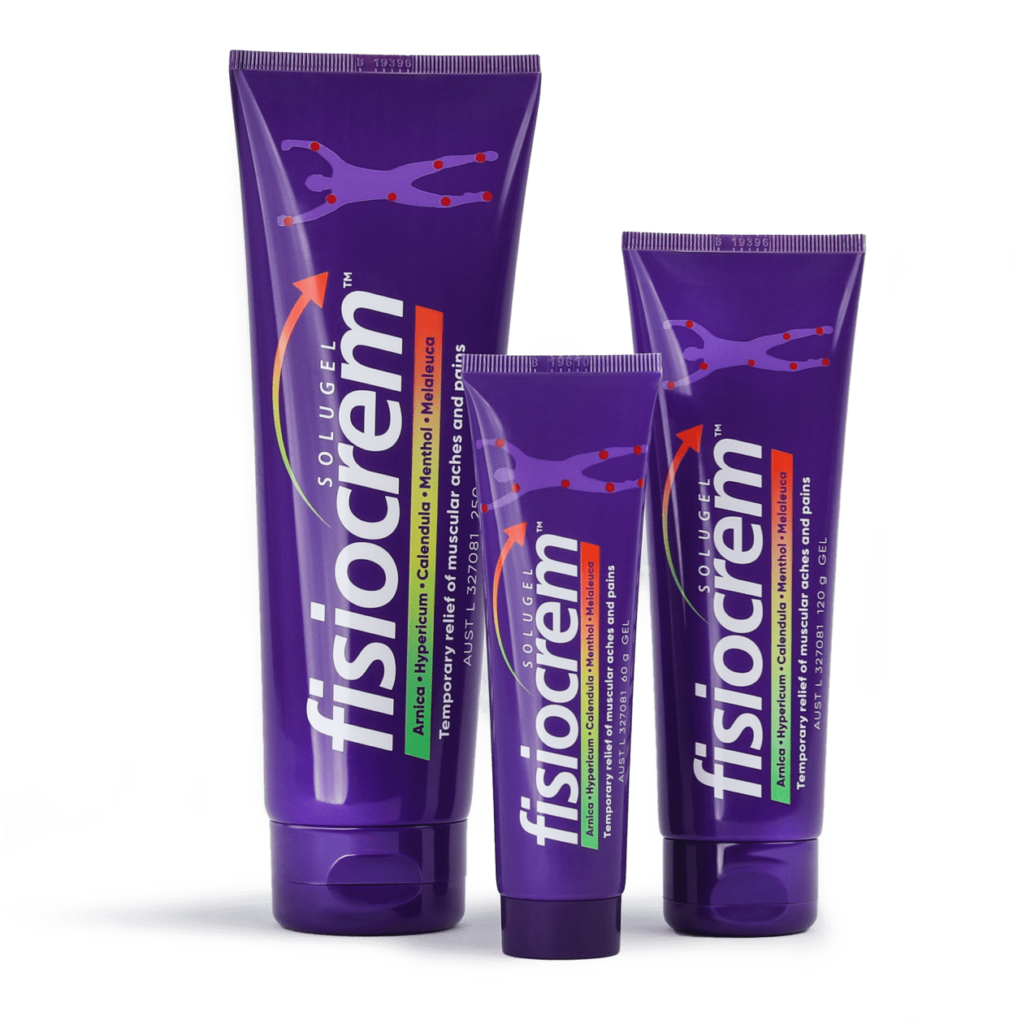
6. Posture Correction
One of the leading causes of neck pain is poor posture (Joshi et al., 2019). Pay attention to how you sit or stand and use furniture that helps support your back and neck.
7. Massage Therapy
Regular massages from a trained therapist can work wonders in reducing neck pain. Massages can help relax muscles and improve blood flow, reducing tension and promoting better circulation (Sherman et al., 2010).
8. Non Operative Options
Non-operative treatments like physical therapy and acupuncture are beneficial in addressing neck pain. Physical therapy utilises exercises and stretches to enhance neck strength and flexibility, improving posture and reducing discomfort. Acupuncture, meanwhile, employs fine needles to stimulate natural pain relief mechanisms and enhance blood circulation, offering holistic pain management. These non-invasive therapies provide effective relief from neck pain, promoting overall well-being (Medical Clinics., 2012).
Conclusion
Dealing with a stiff neck can be a real pain in the neck. But with the right remedies and treatments, you can find relief and get back to your daily activities without discomfort. Remember to pay attention to your posture, perform neck stretches, and use topical pain relief creams when needed.
Taking care of your neck is important for your well-being, whether you use home remedies or get professional help.
FAQs:
1. What is a good remedy for a stiff neck?
A good remedy for a stiff neck includes heat or cold therapy, gentle neck stretches, and over-the-counter pain relievers. Using muscle pain relief gels like fisiocrem can also provide temporary muscle pain relief.
2. What are the best stretches for a stiff neck?
The best stretches for a stiff neck include neck tilts, head turns, and shoulder rolls. These gentle exercises help relieve tension and improve flexibility.
3. What is best for a stiff/sore neck, heat or cold?
Both heat and cold therapy can be effective for a stiff or sore neck. Heat relaxes tense muscles, while cold reduces inflammation. You can choose the one that provides the most relief for your specific condition.
4. How to prevent or relieve a stiff neck while travelling?
To prevent or relieve a stiff neck while travelling, make sure to sit properly and support your neck with a travel pillow. Take breaks during long journeys to stretch and move your neck.
fisiocrem Solugel 60g tube is perfect for on-the-go to keep in your travel bag. The topical gel for muscular pain can help relieve inflammation and provide temporary muscle pain relief.
5. What exercises help relieve neck pain?
Gentle neck exercises like neck rotations, chin tucks, and shoulder stretches can help relieve neck pain and prevent stiffness.
6. Are there any ways to treat neck pain without a doctor?
Yes, there are several ways to treat neck pain without seeing a doctor. You can try different methods to relieve neck pain at home. These include heat or cold therapy, gentle neck exercises, over-the-counter pain relievers, topical creams, and supportive pillows. However, if the pain persists or worsens, it’s advisable to consult a healthcare professional.
Citations
- Ariëns, G., Mechelen, W., Bongers, P., Bouter, L., Van der Wal, G. (2000). Physical risk factors for neck pain. Scandinavian Journal of Work, Environment & Health.
- Bovin, G., Schradar, H., Sand, T. (1994). Neck Pain in the General Population. Spine Journal.
- Cohen, S. (2015). Epidemiology, Diagnosis, and treatment of neck pain. Symposium on pain medicine.
- Côté, P., Cassidy, J. D., & Carroll, L. (2003). The epidemiology of neck pain: what we have learned from our population-based studies.
- Cramer, H., Baumgarten, C., Choi, K., Lauche, R., Saha, F., Musial, F., Dobos, G. (2012). Thermotherapy self-treatment for neck pain relief—A randomized controlled trial. European Journal of Integrative Medicine, 4(4), e371-e378.
- Evans, G. (2014). Identifying and treating the causes of neck pain. Medical clinics.
- Garra, G., Singer, A. J., Leno, R., Taira, B. R., Gupta, N., Mathaikutty, B., & Thode, H. J. (2010). Academic Emergency Medicine, 17(5), 484–489.
- Hoy, D., Protani, M., De, R., Buchbinder, R. (2010). The epidemiology of neck pain. Best practice & Research clinical Rheumatology.
- Joshi, S., Balthillaya, G., & Neelapala, Y. V. R. (2019). Thoracic Posture and Mobility in Mechanical Neck Pain Population: A Review of the Literature.
- Louw, S., Makwela, S., Manas, L., Meyer, L., Terblanche, D., & Brink, Y. (2017). Effectiveness of exercise in office workers with neck pain: A systematic review and meta-analysis.
- Medical clinics., (2012). Identifying the Musculoskeletal Causes of Neck Pain. Retrieved from https://www.hcplive.com/view/identifying-musculoskeletal-causes-neck-pain
- Pang, J., Tsang, S., Fu, A. (2021). The effects of pillow designs on neck pain, waking symptoms, neck disability, sleep quality and spinal alignment in adults: A systematic review and meta-analysis. Clinical Biomechanics.
- Sherman, K. J., Cherkin, D. C., Hawkes, R. J., Miglioretti, D. L., & Deyo, R. A. (2010). Randomized trial of therapeutic massage for chronic neck pain.
- Tunwattanapong, P., Kongkasuwan, R., & Kuptniratsaikul, V. (2015). Clinical Rehabilitation, 30(1), 64–72.
- William, J. R., Srikantaiah, S., & Mani, R. (2013). Cryotherapy for acute non‐specific neck pain – William, JR – 2013: Cochrane Library.
Unlocking your SI Joint (sacroiliac joint) and More
Stretching is a simple practice that can bring significant benefits to your body (Page, 2012). In this blog, we will explore stretching, including static and dynamic stretching, and unlocking your SI joint (sacroiliac joint). So, let’s limber up and explore the world of flexibility and mobility.
Introduction: The Importance of Stretching
Human movement is dependant on the amount of range of motion (ROM)(Page, 2012). Athletes, older adults, rehabilitation patients, and individuals of all ages and fitness levels commonly use stretching as a practice (Page, 2012). Stretching can help improve range of motion (ROM), by increasing flexibility, reducing muscle tension and helping reduce the risk of muscular injury (Woods et al., 2007).
What is stretching?
Stretching involves lengthening your muscles to improve their range of motion. You can do this through three main types: static, dynamic, and PNF stretching (Proprioceptive Neuromuscular Facilitation) (Peck et al., 2014).
Stretching exercises can prevent muscle injuries and improve athlete performance. However, it is important to do them correctly and with caution to avoid injury (Beaulieu, 1981)

What is Static Stretching?
Static: A gentle approach
Static stretching is perhaps the most familiar form of stretching. It is most commonly referred to the safest type of stretching (Beaulieu, 1981). Static stretching is when you stretch a muscle and hold it in an uncomfortable position for 15-30 seconds (Peck et al., 2014). This type of stretching is gentle and safe, making it suitable for people of all fitness levels.
Benefits of Static
Static stretching offers several advantages, including:
- Improved flexibility and an increased range of motion (Kokkonen et al., 2007).
- Reduce the risk of injury and reduce muscle soreness and tension (Sim et al., 2009).
- Helps to enhance physical function and improve quality of life (Masic et al., 2023).
Beginners can perform static stretches daily to keep their muscles flexible and healthy.
What is Dynamic Stretching?
Dynamic stretching involves moving parts of the body and gradually increasing range of motion, speed of movement, or both through controlled movements (Leon & Rana, 2012). In dynamic movements, muscles lengthen, followed by a contraction, and the muscles, joints, tendons, and ligaments must generate force in this stretched position, enhancing functional ability in these extended ranges of motion (Kovacs, M. 2009).
Dynamic stretching is an activity specific functional stretching exercise that should utilise specific movements to prepare the body for activity (Kovacs, 2009). Dynamic stretches have become a popular choice as a pre-exercise warm up (Leon & Rana, 2012).
An example of a dynamic stretch is the walking lunge with rotation and the hamstring hand walk. Both exercises require a strength and flexibility and are a perfect way to improve balance and coordination whilst warming up (Kovacs, 2009).

What is PNF Stretching?
The Science Behind PNF
Proprioceptive Neuromuscular Facilitation (PNF) is a common practice for increasing range of motion. People use PNF to enhance muscle flexibility and muscle strength (Hindle et al 2012).
PNF stretching involves using the opposing muscle to stretch the target muscle. To achieve this, briefly contract the opposing muscle and then hold the target muscle in a static contraction (Sharman et al. 2006).
Sports training and rehabilitation environments commonly employ PNF techniques to enhance both active and passive range of motion (Sharman et al. 2006).
Achieving Enhanced Flexibility with PNF
PNF stretching is effective in:
- Improving flexibility and range of movement (Hindle et al. 2012).
- Enhancing muscle strength and performance (Hindle et al. 2012).
- Decreases muscle tension (Hindle et al. 2012).
- Improving joint stability and mobility (Namura et al. 2008).
Safety: Dos and Don'ts
Avoiding Common Mistakes
Whilst there are many benefits to stretching it is important to do it correctly to avoid injuries. Some common mistakes to avoid include:
- Bouncing whilst performing a stretch (This can lead to muscle strains).
- Neglecting to warm up before stretching.
- Overstretching and causing pain.
- Holding your breath during stretches.
Staying Safe During Your Routine
To ensure a safe and effective stretching routine, remember to:
- Warm up your muscles with light activity.
- Breathe deeply and rhythmically while stretching. Try using yoga breathing techniques.
- Listen to your body and avoid pushing too hard. Stretch only to the point of mild tension.
- Stay consistent with your stretching regimen. Stretch frequently to see the most improvement.
Stretch for Specific Goals
Stretching For Athletes: Optimising Performance
Athletes can benefit greatly from targeted stretching routines. It can help improve:
- Flexibility for better range of motion.
- Injury prevention by increasing muscle flexibility.
- Recovery by reducing muscle soreness and tension post-workout.
- Performance by enhancing muscle power and endurance
Stretching Accessories: Enhancing Your Practice
Stretching can be even more effective when you have the right tools at your disposal. Here’s how some common accessories can enhance your practice:
- Yoga Mats: Provide a comfortable surface for stretching and yoga exercises, ensuring stability and cushioning for your body.
- Resistance Bands: These versatile bands add resistance to your stretches, helping to improve muscle strength and flexibility.
- Yoga Blocks: Assist in maintaining balance and stability during challenging stretches and poses.
Choosing the right accessories for your routine can make a significant difference in your overall experience and results.
How to Unlock Your SI Joint by Yourself
Understanding the SI Joint
The sacroiliac joint (SIJ) is a common cause of lower back pain and buttock pain. The SIJ is a point where the spine and the pelvis connect.
The SI joint is a large joint in the body. It supports the upper body and transfers forces between the upper and lower parts of the body (Divisions, 2005). When this joint is dysfunctional it can cause lower back pain and discomfort (Divisions, 2005).
Treatment of SI joint pain is one of the most challenging problems confronting pain physicians. Generally there are 2 treatment categories; those directed at correcting the underlining pathology and those aimed to alleviate symptoms (Divisions, 2005).
Treatment aimed at relieving symptoms begins with non operative interventions including physical therapy or chiropractic care (Rashbaum et al. 2016). There are other non-surgical treatments that can help reduce pain. These treatments include moving the joint, taking anti-inflammatory drugs, and using sacroiliac joint belts (Foley & Buschbacher, 2006).
Please consult your healthcare professional for their assistance and guidance for treatment and techniques to unlock the SI joint. Unlocking your SI joint can help alleviate pain and restore proper functionality.
fisiocrem Solugel
The Perfect Complement
To maximise the benefits of your routine, consider using fisiocrem products.
fisiocrem Solugel is a topical pain relief cream specially formulated to provide temporary relief from muscle pain. Here’s why fisiocrem Solugel can be the perfect complement:
- Pain Relief: fisiocrem Solugel helps with muscle pain using arnica and calendula. Great for after exercise.
- Contains menthol and naturally derived active Ingredients: avoid the use of synthetic chemicals by using fisiocrem Solugel. fisiocrem Solugel is gentle on your skin.
- Easy to apply pain relief cream absorbs quickly, leaves no residue, so you can stretch without interruptions.
Shop fisiocrem Solugel
To enhance your routine and alleviate any discomfort or pain that may arise during or after stretching, incorporate fisiocrem Solugel
Shop fisiocrem Solugel for muscular aches and pains in-store at your local pharmacy, Chemist Warehouse, Coles, and Woolworths. Purchase fisiocrem directly online, with all orders qualifying for free delivery.


Conclusion: Embrace the Power of Stretching
In conclusion, stretching is a fundamental practice that can benefit everyone, regardless of age or fitness level. Whether you’re looking to improve flexibility, or relieve stress, there’s a stretching method that suits your needs.
From the gentle and accessible static to dynamic and PNF, you have a variety of options to explore. Stretch safely, avoid mistakes, use mats, bands, and blocks to improve your yoga practice.
fisiocrem Solugel can help with muscle pain and soreness, giving you effective relief.
So, what are you waiting for? Start integrating stretches into your daily life, and you’ll discover a world of improved flexibility, reduced pain, and enhanced well-being.
FAQs: Answering Your Burning Questions
1. What Are the Best Times to Stretch?
The best times to stretch are during warm-ups prior to exercise and cool-downs. You can add stretching to your daily routine. You can do it either in the morning to wake up or in the evening to relax after a long day.
You can add stretching to your daily routine. You can do it either in the morning to wake up or in the evening to relax after a long day.
2. How Long Should I Hold a Stretch?
Ideally, you should hold a stretch for 15-30 seconds. This duration allows you to relax the muscle and elongate the muscle gradually without causing strain.
3. Is It Good for Pain Relief?
Yes, stretching can help alleviate muscle and joint pain. It increases blood flow, reduces muscle tension, and promotes relaxation, which can contribute to pain relief.
4. Is it possible to use fisiocrem Solugel after stretching?
You can use fisiocrem Solugel after stretching. Using fisiocrem after stretching helps with post-stretching recovery by relieving discomfort or soreness.
These FAQs give general advice, but it’s best to talk to a healthcare professional for help with stretching and relieving pain.
Citations
- Beaulieu, J. E. (1981). The Physician and Sportsmedicine, 9(11), 59–69.
- Divisions, P. M. (2005). Sacroiliac Joint Pain: A Comprehensive Review of Anatomy, Diagnosis, and treatment. Anesthesia & Analgesia.
- Foley, B., Buschbacher, R. (2006). Sacroiliac Joint Pain: Anatomy, Biomechanics, Diagnosis, and treatment. American Journal of Physical Medicine & Rehabilitation.
- Hindle, K. B., Whitcomb, T. J., Briggs, W. O., & Hong, J. (2012). Proprioceptive Neuromuscular Facilitation (PNF): Its Mechanisms and Effects on Range of Motion and Muscular Function. Journal of Human Kinetics.
- Kokkonen, J., Nelson, A., Eldredge, C., Winchester, J. (2007). Chronic Static Stretching Improves Exercise Performance. Official Journal of the American College of Sports Medicine.
- Kovacs, M. (2009). Dynamic stretching: The Revolutionary New Warm-up Method to Improve Power, Performance and Range of Motion.
- Leon, C., Oh, H.-J., & Rana, S. (2012). Strategies, 25(5), 16–19.
- Masic, S., Causevic, D., Covic, N., Spicer, S., & Gawash, A. (2023). The Benefits of Static Stretching on Health. A Systematic Review.
- Namura, M., Motoyoshi, M., Namura, Y., Shimizu, N. (2008). The effects of PNF training on the facial profile. J Oral Sci.
- Page, P. (2012). Current concepts in muscle stretching for exercise and rehabilitation. International journal of sports physical therapy.
- Peck, E., Chomko, G., Gaz, D., Farrell, A. (2014). The Effects of Stretching on Performance. Current Sports Medicine Reports.
- Rashbaum, R. F., Ohnmeiss, D. D., Lindley, E. M., Kitchel, S. H., & Patel, V. V. (2016). Sacroiliac Joint Pain and Its Treatment.
- Sharman, M. J., Cresswell, A. G., & Riek, S. (2006). Sports Medicine, 36(11), 929–939.
- Sim, A., Dawson, B., Guelfi, K., Wallman, K., Young, W. (2009). Effects of Static Stretching in Warm-Up on Repeated Sprint performance: The Journal of Strength & Conditioning Research.
- Woods, K., Bishop, P., & Jones, E. (2007). Sports Medicine, 37(12), 1089–1099.
Introducing fisiocrem sponsored athlete Kirsty, a dedicated mother of two, juggling a demanding full-time job in the railway sector alongside her pursuit of a Master’s degree in business.
At the moment, Kirsty’s favorite sport is trail running, and she cherishes the freedom that comes with exploring forested trails, far from the hustle and bustle of the busy city. Another passion of hers is the running community; she finds immense inspiration from the incredibly motivating individuals within it, particularly her fellow trail running companions and the esteemed members of the purple army. Kirsty also revels in pushing her limits, having completed two ultra trails (50km and 60km) and harboring a strong desire to achieve even more. She’s set to tackle a 50km run in October and aspires to make 2024 the year of her first 100km race.
One could say Kirsty’s most significant fitness achievement is discovering an activity she loves. Although she was always active and engaged in sports like soccer and softball while growing up, her athletic pursuits came to a halt during her first pregnancy when she grappled with post-natal depression. Seeking natural remedies for her condition, Kirsty took inspiration from her sister, who was deeply involved in running. She began her journey with road running and, after a few years, transitioned to trail running. Since then, she hasn’t looked back, as her entire being comes alive while navigating the trails. Over the past couple of years, Kirsty has also placed significant emphasis on her diet and internal healing, recognizing the transformative power of combining physical training with a healthy diet.
To navigate her fitness journey, Kirsty has enlisted the support of an exceptional online coach (@run_coaching on Instagram), Matt, who has crafted a program tailored to her lifestyle. This program incorporates elements such as strength training, stretching, and rest days, all to complement her running. Despite the challenges of being a full-time working mother and a university student pursuing her Master’s degree, Kirsty acknowledges that her plan doesn’t always unfold as expected. However, she firmly believes that by consistently prioritizing strength and stretching, she can at least make it to the starting line and ultimately cross the finish line, no matter the hurdles.
Kirsty finds her children to be a driving force, motivating her to continuously push her boundaries and demonstrate that any goal is attainable with determination, regardless of how unconventional it may seem to others. She also draws inspiration from skeptics who doubt her capabilities, viewing their skepticism as additional fuel to dream even bigger and set increasingly ambitious.
KIRSTY’S TOP RECOVERY TIPS
Kirsty’s mantra revolves around the importance of consistently tending to the small things in her fitness journey: mobility, strength training, stretching, foam rolling, maintaining a balanced diet, and relying on products like fisiocrem—she embraces these practices unwaveringly.
"My whole soul comes alive after a day of chasing trails."
Kirsty Lightbody
Meet fisiocrem sponsored athlete Debbie, our 54-year-old sponsored running enthusiast. Debbie loves to “mix it up” with trails and road runs, along with the occasional cycle.
Debbie’s favourite activity will always be trail running. She pushes her limits and has a good routine in place to conquer her goals. She says, “To achieve something greater than the normal person means everything to me.”
Debbie has just finished training for Trail Trips Coastal High 50km earlier this Month. It’s been a long and tough road back for her, since undergoing major hip/glute surgery in October last year. Debbie says, “I’m ready to build up my km’s again by increasing my strength work at gym.”
When asked about who supports and motivates her Debbie says, “I am supported by my family and good friends but at the end of the day, it’s just me and I do these crazy adventures to see what I am capable of achieving.”
“I am motivated by many people around me, those who run, cycle and those who can’t. We have one life, and you need to do whatever you can in the time we have to enjoy it.”
Reflecting on her fitness journey, Debbie’s most significant achievement thus far has been completing a 100-miler race a few years ago.
She explains that she dedicated this race for Matt, her brother-in-law who sadly passed away 3 weeks prior. “I was so determined and was not going to quit; it was all for Matt.”
Debbie also completed the Scenic Rim event back in August, she achieved 105km. She describes it as ” Amazing, Muddy and Wet”. Despite the obstacles in her way, never giving up was the key!
DEBBIE’S TOP RECOVERY TIPS
Debbie says, ‘‘We are all different and need to learn our limitations. If you push your limits, you need to recover the right way with sleep, food and post stretching.”
"To achieve something greater than the normal person means everything to me."
Debbie Gilchrist
Posture has a direct correlation to the comfort, mechanical efficiency, and physical functioning of an individual’s body (Howorth, B. 1946). Good posture is essential for maintaining a healthy musculoskeletal system and preventing discomfort and pain.
You should think of posture as both static positions and the dynamic posture of the body in motion. Static positions include lying, sitting, standing, and various other positions (Howorth, B. 1946).
Occupations that require prolonged static positioning, heavy manual work, shift work, and repetitive sports may all contribute to postural position changes and may result in pain (Britnell, S., Cole, J., Isherwood, L., Sran, M., Burgi, S., Candido, G., Watson, L. 2005).
In today’s lifestyle, many individuals struggle with poor posture, especially when sitting for extended periods. However, there are steps you can take to fix bad posture and alleviate the associated muscle aches and pains. In this article, we will give tips and techniques to improve your posture, especially when sitting down.
Understanding the importance of Good Posture
Before diving into the strategies for fixing bad posture, it’s crucial to understand why it matters. Good posture helps align the body’s musculoskeletal structure, reducing strain on muscles, joints, and ligaments. It enhances balance, promotes optimal breathing, and prevents excessive wear and tear on the body. By prioritising good posture, you can improve overall well-being and reduce the risk of musculoskeletal issues in the long run.
Good posture requires balance, which is necessary when we lie down, ski, walk, etc. When the equilibrium of the body is impaired as a result of exhaustion, mishap, illness, or profession, the effectiveness of the body’s mechanics diminishes (Hansson, K. 2013).
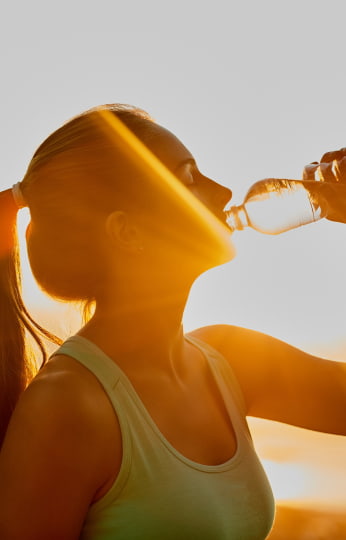
Tips for improving your posture
1. Sleep Posture
Pay attention to your sleeping posture. A good mattress and pillow that support the natural curve of your spine can make a significant difference in your posture and overall comfort. Sleep position is important and can assist in preventing neck and shoulder musculoskeletal pain (Lee, W., & Ko, M. 2017).
2. Stay Hydrated
Proper hydration helps in the preservation of muscular functions which can assist with better posture control (Gauchard, G., Gangloff, P., Voucriot, A., Mallie, J., Perrin, P. 2009).
3. Maintain a Healthy Weight
Excess weight can strain your spine and contribute to poor posture (Gilleard, W., & Smith, T. 2006). Maintaining a healthy weight through diet and exercise can help alleviate this issue.
4. Stretching Exercises
Incorporating yoga and stretching exercises into your routine can improve flexibility and posture. Practices like yoga and pilates specifically target posture and core strength.
Tips for improving posture when sitting.
1. Sit with Proper Ergonomics
One of the primary causes of poor posture when sitting is inadequate ergonomics. To support your body’s natural alignment, consider the following tips when in a sitting position:
- Modify the height of your chair to ensure your feet are flat on the floor.
- Maintain a slight forward tilt of the chair to keep your pelvis in a neutral position.
- Position your computer screen at eye level to avoid straining your shoulders and neck.
- Use an ergonomic chair or add lumbar support to maintain the natural curve of your lower back.
- Bend your elbows at a 90-degree angle and keep your wrists in a neutral position when typing.
2. Take Frequent Breaks and Stretch
Sitting for prolonged periods can contribute to poor posture and muscle stiffness. Prevent this by regularly taking breaks and integrating stretching exercises into your everyday schedule. Stand up, walk around, and perform simple stretches to relieve tension in your muscles. Focus on stretching your neck, shoulders, chest, and back to counteract the effects of prolonged sitting.
3. Strengthen Your Core Muscles
Strong abdominal muscles are vital for maintaining good posture. Engaging your core muscles helps stabilise your spine and provides support for your upper body. Consider performing exercises such as planks, bridges, and abdominal crunches into your fitness routine. By strengthening your core, you can improve your posture and reduce the risk of back pain.
4. Practice Mindful Sitting
Developing awareness of your posture while sitting is key to making lasting improvements. Proper sitting involves paying attention to your body’s alignment and making necessary adjustments throughout the day. Regularly check your seated position to ensure you relax your shoulders, keep your spine straight, place your feet flat on the floor, and align your head with your body. Over time, this mindful approach will become second nature, leading to improved posture even when you’re not actively thinking about it.
5. Utilise Posture-Correcting Tools
In addition to implementing lifestyle changes, you can also benefit from posture-correcting tools. There are various options available, such as ergonomic chairs, lumbar rolls, and posture braces. These tools provide additional support and encourage proper alignment.
Shop Posture Medic – a solution to help you improve your posture.
fisiocrem Solugel
For back & neck muscle pain relief.
fisiocrem Solugel is a topical pain relief cream for the temporary relief of muscular aches and pains associated with poor posture.
fisiocrem Solugel contains naturally derived active ingredients. fisiocrem Solugel’s blend of active ingredients provides the following benefits:
- Relieve Inflammation
- Helps in the healing of mild muscle injuries and ailments
- Helps in the management of muscle sprains and muscle strains
- Relieve muscle pain and soreness
Shop fisiocrem Solugel for muscular aches and pains in-store at your local pharmacy, Chemist Warehouse, Coles, and Woolworths. Purchase fisiocrem directly online, with all orders qualifying for free delivery.


Apply a few grams of fisiocrem Solugel to the affected area 3 to 4 times daily, or as often as required. Massage fisiocrem Solugel in as required.
If symptoms persist consult your health care practitioner. This is only for external use. Do not use fisiocrem on broken skin. Please avoid contact with your eyes.
Should your skin be sensitive, conduct a patch test with this product before using it on a larger area. If sensitivity develops discontinue use.
Always read the label and follow the directions for use.
Citations
- Britnell, S., Cole, J., Isherwood, L., Sran, M., Burgi, S., Candido, G., Watson, L. (2005). Postural Health in Women: The Role of Physiotherapy. Retrieved: https://citeseerx.ist.psu.edu/document?repid=rep1&type=pdf&doi=b6b90023a14438195f27cfc4263479927540bf92
- Gauchard, G., Gangloff, P., Voucriot, A., Mallie, J., Perrin, P. (2009). Effects of exercise-induced fatigue with and without hydration on static postural control in adult human subjects. International Journal of Neuroscience, 112 (10) 1191-1206.
- Gilleard, W., & Smith, T. (2006). Effect of obesity on posture and hip joint moments during a standing task, and trunk forward flexion motion. International Journal Of Obesity, 31(2), 267-271.
- Hansson, K. (2013). Body Mechanics and Posture. The Journal of Health and Physical Education, 16(10) 549-587.
- Howorth, B. (1946). Dynamic Posture. Journal Of The American Medical Association, 131(17), 1398.
- Lee, W., & Ko, M. (2017). Effect of sleep posture on neck muscle activity. Journal Of Physical Therapy Science, 29(6), 1021-1024.
Mild osteoarthritis (OA) is frequent and is the leading cause of persistent musculoskeletal pain. It is a common degenerative disease that affects millions of people with symptoms ranging from joint pain, stiffness to inactivity and swelling (Kidd, B. 2006)
Within this article, we will look at what mild OA is, what causes it, and how to treat it effectively. We will look at areas commonly affected by mild OA, for example, the knees, hips, and fingers. We will discuss exercises that can help reduce pain and stiffness associated with mild OA.
*fisiocrem Joint ease is for the temporary relief of symptoms associated with mild forms of OA.
What is mild osteoarthritis?
Mild osteoarthritis is the most common type of mild arthritis and is a type of mild arthritis that causes joint pain and impairs movement. Mild osteoarthritis occurs due to a breakdown of cartilage between bones and joint inflammation (Yue, L., & Berman, J. 2022).
This gradual breakdown of cartilage leads to joint pain, stiffness, and reduced mobility and can affect any joint in the body. The most common joints affected are the knees, hips, feet, and hands.
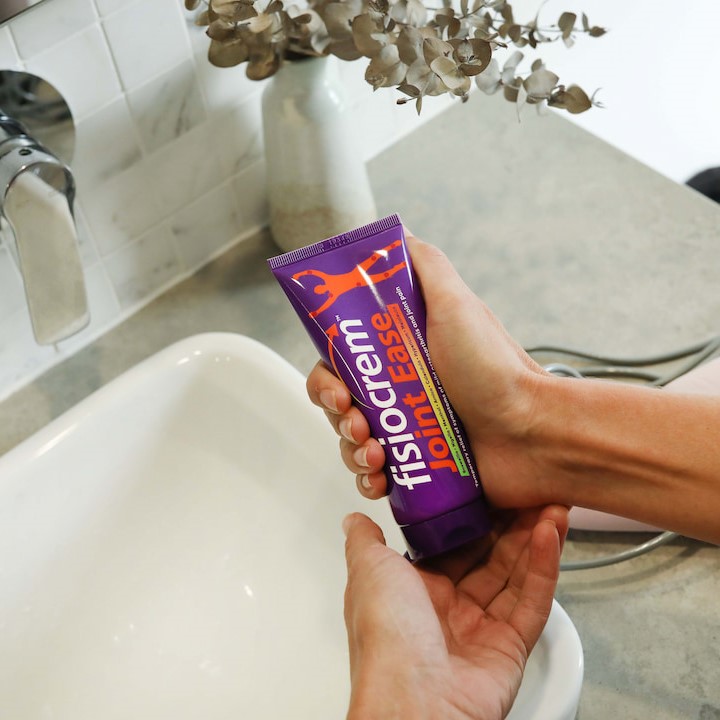
What causes mild osteoarthritis?
While the exact cause of mild osteoarthritis is unknown, several factors can contribute to its development. These include:
- Age: mild osteoarthritis is more common in older people. Over time, the joints can suffer wear and tear, which can lead to the onset of mild osteoarthritis (Yue, L., & Berman, J. 2022).
- Joint injury: Previous joint injury such as a ligament tear in the knee joint or an ankle fracture can increase the risk of developing mild OA later in life (Lohmander, S. 2000).
- Genetics: Certain genetic factors can make individuals more susceptible to mild OA. The prevalence of mild osteoarthritis increases for people of the female sex (Lohmander, S. 2000).
- Obesity: Excess weight puts additional stress on the joints, particularly weight-bearing joints such as the knees and hips. Weight can accelerate the degeneration of cartilage (Yue, L., & Berman, J. 2022).
Mild osteoarthritis symptoms
Mild osteoarthritis can cause both substantial physical and psychosocial disability (Hunter, D., McDougall, J., & Keefe, F. 2008). Therefore recognising the symptoms of mild osteoarthritis is crucial for early detection and effective management
Common symptoms include:
- Joint Pain: Persistent pain is the most predominant symptom and sign of mild OA (Hunter, D., McDougall, J., & Keefe, F. 2008). Pain in the affected joints may increase with movement or after prolonged periods of inactivity (Yue, L., & Berman, J. 2022).
- Joint stiffness is common, particularly in the morning. It usually lasts less than 30 minutes or after periods of rest (Sinusas, K. 2012).
- Range of motion is limited: Moving the affected joint can be difficult, causing reduced flexibility and mobility. This can lead to disability in everyday activities (Sinusas, K. 2012).
- Swelling: Mild to moderate swelling around the joint area (Bijlsma, J., Berenbaum, F., & Lafeber, F. 2011).
- Joint Grating Sensation: A grating or crackling sound during joint movement, known as crepitus (Bijlsma, J., Berenbaum, F., & Lafeber, F. 2011).
*fisiocrem Joint ease is for the temporary relief of symptoms associated with mild forms of mild osteoarthritis.
Mild osteoarthritis Treatment
While there is no cure for mild osteoarthritis there are several treatment options. These treatment options can help to reduce and manage the symptoms of mild osteoarthritis whilst improving joint function. These treatment options aim to improve the quality of life for individuals with this condition. These include:
- Weight loss and lifestyle changes: Dietary modifications and exercise can lead to significant weight loss. This, in turn, can reduce joint pain and improve joint function (Yue, L., & Berman, J. 2022).
- Physical therapy: Physical therapy can also provide guidance on exercises to improve joint strength and flexibility.
- Regular exercise: exercise helps ease mild arthritis pain and stiffness. Get moving with mild Arthritis moves exercises.
Keeping active is vital for people living with mild osteoarthritis. Learn more about a 12-week virtual exercise program to help people stay motivated. The program provides safe exercises, such as those for mild knee arthritis. Additionally, it offers resources and support.
The above treatment options help to build muscle strength, reduce the stress placed on joints and improve functional movement (Yue, L., & Berman, J. 2022).
- Topical pain relief creams: Mild osteoarthritis self-care treatments like over-the-counter pain relievers, can help alleviate pain and reduce inflammation.
*fisiocrem Joint ease is for the temporary relief of symptoms associated with mild forms of OA.
Other treatment options can include:
- Assistive Devices: The use of assistive devices, such as braces, can help support the affected joint and reduce pain during movement.
- Alternative Therapies: Some individuals find relief through complementary and alternative therapies, such as acupuncture or massage
Mild Knee Osteoarthritis
Mild knee osteoarthritis is a prevalent form of mild osteoarthritis that affects the knee joints. It can significantly impact a person’s daily life and overall well-being. There are various strategies to manage mild knee osteoarthritis and improve the condition such as regular exercise tailored specifically for the knees.
Engaging in targeted exercises can help strengthen the muscles surrounding the knee joint, improve flexibility, and alleviate pain and stiffness. Examples of exercises beneficial for mild knee osteoarthritis include low-impact activities like walking, swimming, and cycling.
Additionally, stretching exercises, such as quadriceps and hamstring stretches, can help increase joint flexibility. Consult with a healthcare professional or qualified physical therapist before starting any exercise regimen. This will ensure the regimen is appropriate for your specific condition. With proper care and exercise, individuals with mild knee osteoarthritis can enhance their quality of life and regain mobility.
Hips
Mild Osteoarthritis in the hip joint can be a source of significant discomfort and limitation. The degenerative nature of mild hip osteoarthritis leads to pain, stiffness, and reduced range of motion in the hip area.
Maintaining a healthy weight can help reduce stress on the hip joint. Regular low-impact exercises such as swimming or gentle stretching can improve joint flexibility and strengthen the muscles around it. Assistive devices like canes and walkers can provide extra support and reduce strain on the hip during daily activities. This can make activities easier and more comfortable.
Fingers
Mild osteoarthritis also affects the delicate joints of the fingers, leading to discomfort, stiffness, and diminished hand function. Dealing with mild osteoarthritis in the fingers requires proactive management strategies to alleviate symptoms and maintain hand mobility.
A primary approach is to engage in exercises designed to improve finger strength. These exercises may include finger bends, squeezing stress balls, or using hand grippers.
fisiocrem Joint Ease
For mild osteoarthritis
fisiocrem Joint Ease has been formulated for use in mild forms of osteoarthritis. fisiocrem Joint Ease contains menthol and naturally-derived active ingredients of Boswellia, nigella, arnica, calendula, hypericum, and melaleuca.
fisiocrem Joint Ease is an innovative, discreet, low-odour topical gel that helps to rapidly relieve pain. Our topical pain relief helps to improve inflammation and stiffness, symptoms associated with mild osteoarthritis.
fisiocrem Joint Ease is easy to-apply, non-greasy, non-heat formulation. It is designed to provide ongoing joint comfort and helps to provide mild arthritis pain relief by:
- Helping to promote healthy joint function
- Relieve mild joint pain, soreness, and stiffness
- Maintain joint mobility and flexibility
- Supports body tissue repair

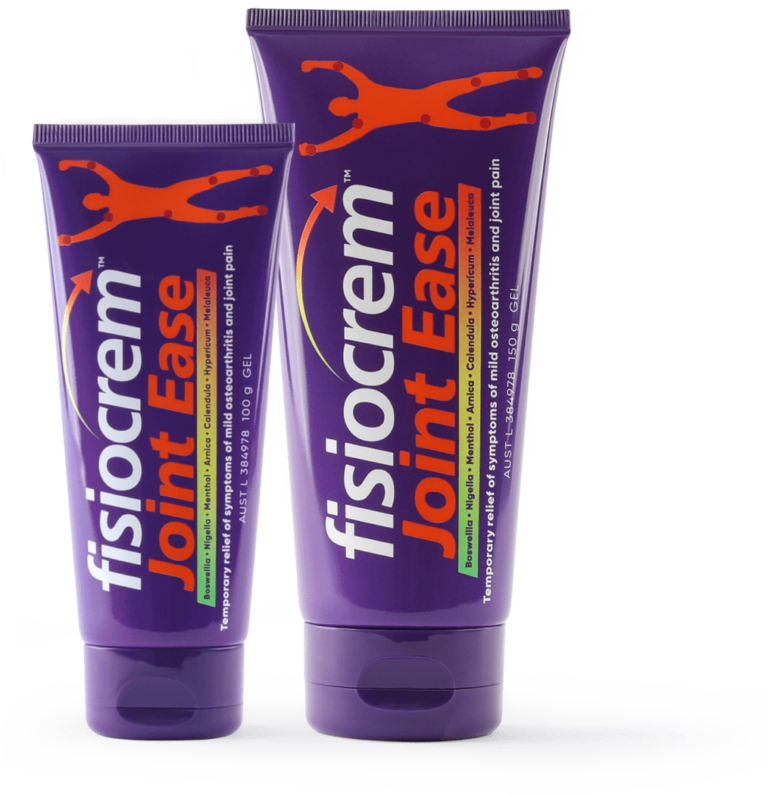
Shop this topical mild osteoarthritis cream Australia-wide.
fisiocrem Joint Ease available in 100g and 150g.
When applying fisiocrem Joint Ease, apply a few grams to the affected area 3 to 4 times daily, or as required. Massage fisiocrem Joint Ease in as required.
Always read the label and follow the directions for use.
Citations
- Bijlsma, J., Berenbaum, F., & Lafeber, F. (2011). The Lancet, 377(9783), 2115-2126.
- Hunter, D., McDougall, J., & Keefe, F. (2008). Rheumatic Disease Clinics Of North America, 34(3), 623-643.
- Kidd, B. (2006). Pain, 123(1), 6-9.
- Lohmander, S. (2000). Arthritis research & therapy, (95).
- Sinusas, K. (2012). Am Fam Physician, 85(1):49-56
- Yue, L., & Berman, J. (2022). JAMA, 327(13), 1300.
Meet fisiocrem sponsored athlete Vicky. An amazing and inspiring mom of three, who also happens to be a successful
entrepreneur running her own business from home. Vicky started her own business 11 years ago, and now works alongside her husband.
This fitness enthusiast enjoys taking on challenges such as the 1-minute burpee challenge (with a personal record of 44 in a minute) and a 100-pushup-per-day challenge with her Keilor Running Club crew to help support mental health. Vicky also also enjoys walking and running with her dog Pippa to keep things fun and interesting.
Vicky is a fitness enthusiast who discovered the high-intensity interval training workout called HIIT STEP a few years ago at her local gym, The Fit Station. She describes how this workout pushes her to her absolute maximum, getting her heart rate up and helping her improve her running ability. HIIT Training has become an essential part of her training routine, and she loves the challenge it brings every time she steps onto the mat.
In October 2016, Vicky began her fitness journey as a way to take some time for herself after having three kids and joined a six-week challenge at her local gym that included a 300m run time test, which sparked her running journey and she still takes on challenges at the gym to stay motivated. Vicky says, ”Finding the right environment that suits you, your family, your schedule, makes all the difference to keep it up & continue the journey. Still to this day, l do like to take on challenges at my gym, just to keep me on track.”
Vicky’s biggest goal is to keep doing what she loves with inspiring friends and continue challenging herself to be the best version of herself, which includes maintaining her fitness and health through running, a challenging pursuit that she hopes will enable her to achieve many other goals in the future, such as potentially participating in the Melbourne Marathon this year.
Vicky credits her running success to the incredible support and encouragement she receives from her running community, the Keilor Running Club. This club’s inclusive environment is what makes it so special to her, as it motivates and inspires every member regardless of their skill level or pace. She feels incredibly grateful to have found her tribe, as they constantly push her to be a better version of herself.
Vicky’s family is also a major support system for her, as they help her juggle her busy schedule and participate in various sports and activities. She emphasizes the importance of self-love and taking care of oneself not only for oneself but also for those they love. Her husband is also an active and fitness-oriented individual, and together they are able to maintain a healthy and active lifestyle that benefits the entire family.
Her biggest weakness when it comes to running is the “runner’s gut,” which is a constant battle for her. As someone who runs approximately four times a week, it can be challenging to eat the right foods since the next day is a run day. However, she finds comfort in discussing it with close friends who are also runners and realizing that she is not alone in this struggle. To ensure that she can manage this issue, she always makes sure to run in areas where there are nearby toilets, and when registering for runs, she plans ahead and checks the map for the location of restrooms.
VICKY’S TOP RECOVERY TIPS
After a long run, Vicky says, ‘‘l love to take a long warm Epsom salts bath for at least 45 minutes, with a few stretches in the bath, it totally puts my body in relaxation mode.’’
”In October 2016, l started my fitness journey, it was time to give back to myself, for myself.”
Vicky Giancola
Meet fisiocrem sponsored athlete Todd. Commonly known as Parko, he is 48 years old and resides on the stunning Coffs Coast in New South Wales, Australia. Todd has been married for 26 years and is a proud father of four amazing adult children.
Todd’s favourite sport is running, but he also enjoys participating in triathlons, even though he struggles with swimming. In 2013, Todd started running and since then, he has completed 8 marathons, 9 half marathons, a few triathlons, and one Ultra Marathon of 61.2km.
Todd hopes to meet and connect with fellow runners at the Gold Coast Marathon or other races throughout the year. So, if you see him out there, be sure to say hi and share your running stories with him.
Vicky is a fitness enthusiast who discovered the high-intensity interval training workout called HIIT STEP a few years ago at her local gym, The Fit Station. She describes how this workout pushes her to her absolute maximum, getting her heart rate up and helping her improve her running ability. HIIT Training has become an essential part of her training routine, and she loves the challenge it brings every time she steps onto the mat.
Todd’s biggest fitness achievement was completing the virtual Ultra Marathon race put on by Run with the world in 2020. Running alone on the local streets around his area was mentally tough, but knowing his family was waiting for him at the finish line kept him motivated to keep going. He finished the race in 5 hours and 36 minutes.
Todd has set some ambitious running goals for himself in 2023. He hopes to run a personal best at the Gold Coast Marathon, with his current PB standing at 3:25:21. He also aims to run a total of 3500km for the year, and although he has fallen behind his planned schedule, he is determined to catch up and achieve this goal by the end of the year.
Todd’s biggest source of motivation and support is his family. He wants to prove to his kids that age is just a number, and with determination and hard work, anything is achievable, even running personal bests at the age of 48. Todd also finds inspiration and motivation in watching the last hour of a marathon or Ironman event. He believes that the last few people to cross the finish line are the real heroes and champions of the race.
Despite being a seasoned runner, Todd admits that his biggest weakness is swimming and his lack of confidence in the water. Nevertheless, he
has set his sights on completing an Ironman someday, knowing that he has a lot of work to do on his swimming to get there.
TODD’S TOP RECOVERY TIPS
After a long run, Vicky says, ‘‘l love to take a long warm Epsom salts bath for at least 45 minutes, with a few stretches in the bath, it totally puts my body in relaxation mode.’’
”Age is just a number and you are still capable of achieving anything you want.”
Todd Parkin
Topical anti-inflammatory creams and ointments have become increasingly popular for their potential to alleviate localised inflammation and provide temporary relief. Inflammation, whether due to injury, mild arthritis, or other conditions, can cause discomfort and hinder daily activities.
What is inflammation?
Inflammation is a cellular response that follows trauma to vessels. Inflammation is described as an essential stage in the process of repairing and responding to injuries, during which the vessels are disrupted. There are two types of pain caused by inflammation they are either acute or chronic inflammation (Scott, A. 2004).
The body’s initial response to an infection or trauma is called an acute inflammatory response. This response is the human body’s first line of defence against danger (Kumar, R., Clermont, G., Vodovotz, Y., & Chow, C. 2004). Acute inflammation is generally short-lived, with inflammation generally disappearing within hours or days.
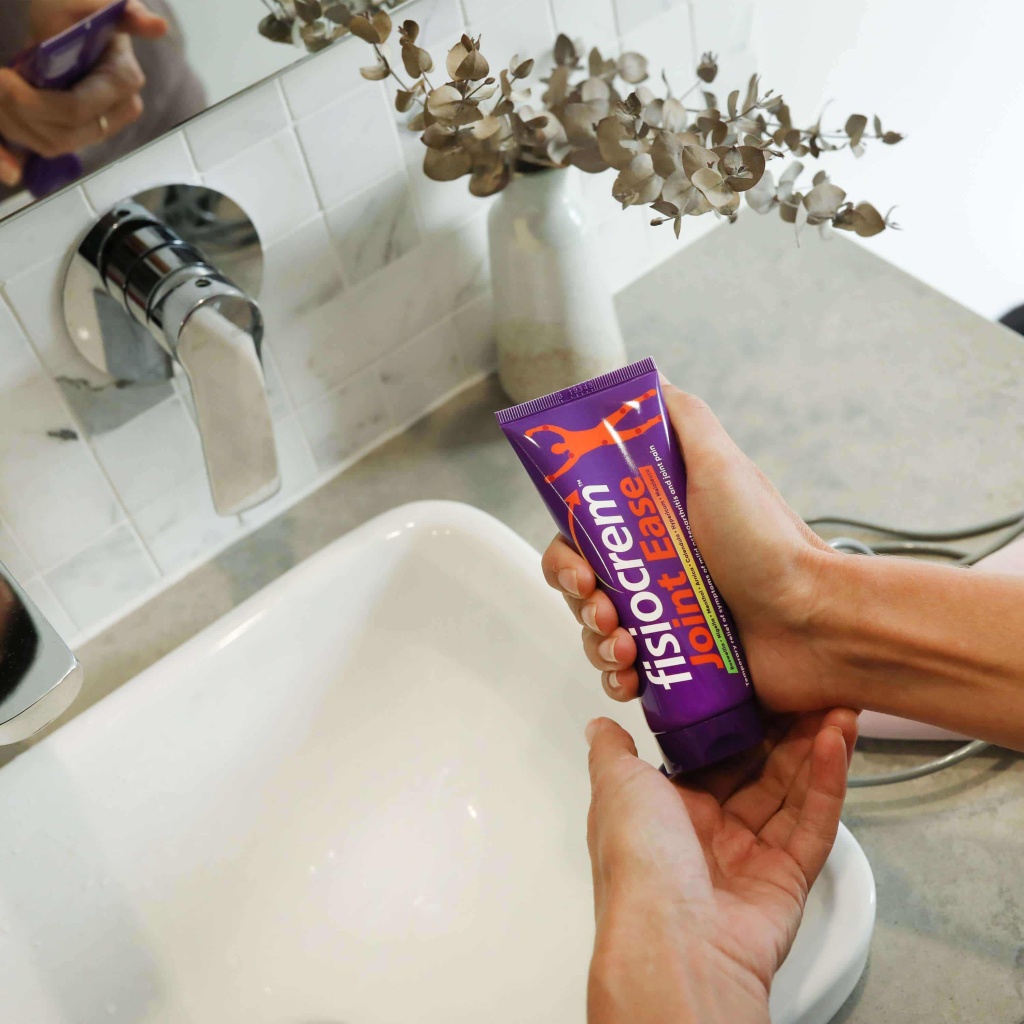
Mild Arthritis
Inflammation is a widespread issue affecting countless individuals. Mild arthritis is a common condition that is associated with inflammation. Mild arthritis leads to painful inflammation of the joints, resulting in restricted mobility and reduced quality of life.
If you are experiencing pain, swelling, stiffness, or other symptoms of long-term inflammation, talk to your healthcare practitioner. A healthcare practitioner can run some tests and evaluate and find better ways to help provide relief.
Symptoms of acute inflammation include pain and swelling (Smith, L. 1991).
*fisiocrem Joint ease is for the temporary relief of symptoms associated with mild forms of arthritis.
Treatment
Treatment of acute inflammation usually involves anti-inflammatory drugs. These may be in the form of tablets, such as NSAID’s, creams or gels, or other self-care remedies (Smith, L. 1991). Swelling and pain can be reduced with these treatments.
An anti-inflammatory diet can have anti-inflammatory effects (Galland, L. 2010). This diet includes fruits such as tomatoes, vegetables, leafy greens, olive oil, nuts, legumes, and grains.
Always read the label and follow the directions for use.
Are topical anti-inflammatory creams effective?
Topical nonsteroidal anti-inflammatory drugs are an alternative to oral NSAID’s (Klinge, S., Sawyer, G. 2015).
Topical anti-inflammatory and analgesic creams are effective in relieving pain. They can help with acute and chronic musculoskeletal disorders, such as mild arthritis, mild osteoarthritis, medically diagnosed tendonitis, and muscle pain. They also provide relief for sprains and strains, as well as overuse injuries (Haroutiunian, S., Drennan, D., & Lipman, A. 2010).
How does an anti-inflammatory cream work?
How to apply a topical anti-inflammatory gel/analgesic cream?
Topical anti-inflammatories influence the particular area that you apply them to. When applied topically the cream/gel is absorbed into your skin. They then move deeper targeting areas of the body where there is inflammation. When applied to the affected area, topical anti-inflammatory creams and gels relieve pain and reduce swelling.
Apply to the affected area and massage into the skin gently. Massaging the product into the skin will increase the blood flow to the affected area. Always wash your hands after application to avoid rubbing the gel or cream into a sensitive area such as the eyes. Ensure that you do not apply the topical cream on broken skin.
Topical anti-inflammatories can be applied 2-4 times daily. However, read the label and follow the directions for use before applying.

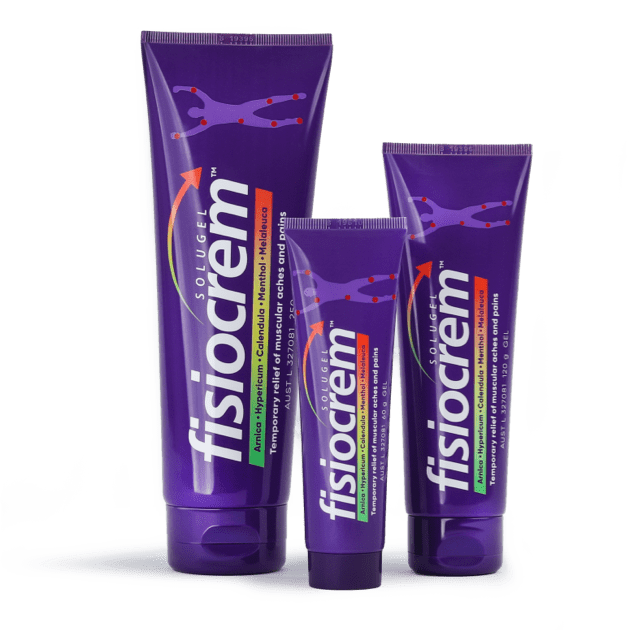
fisiocrem Solugel
Is an over the counter anti-inflammatory for muscle pain.
fisiocrem Solugel is a topical cream designed to relieve muscle pain and relieve inflammation. Its active ingredients include Arnica, Hypericum, Calendula, and Melaleuca. These active ingredients work together to provide anti-inflammatory, analgesic, and healing effects, reducing swelling, pain, and stiffness in affected muscles. fisiocrem Solugel is perfect for use after exercise or any physical activity that causes muscle pain or soreness.
When applying fisiocrem Solugel, apply a few grams to the affected area 3 to 4 times daily, or as required. Massage fisiocrem Solugel in as required.
If symptoms persist consult your health care practitioner. This is only for external use. Do not use fisiocrem on broken skin. You should avoid contact with your eyes.
Before using an anti-inflammatory cream for children, always read the product label and consult your general practitioner. For children under 3 years of age, please consult your general practitioner before using fisiocrem.
If you have sensitive skin, test this product on a small patch of skin before applying it to a larger area. If sensitivity develops discontinue use. Always read the label and follow the directions for use.
fisiocrem Joint Ease
Topical anti-inflammatory for the temporary relief of mild arthritis, mild osteoarthritis, and joint pain.
fisiocrem Joint ease, on the other hand, is a targeted cream that helps relieve joint pain and inflammation. It contains active ingredients such as Arnica, Calendula, and Boswellia, which are well-known for their anti-inflammatory properties.
These ingredients work in unison. They reduce inflammation, swelling, pain, and stiffness in joints affected by certain conditions. These conditions include mild arthritis, and mild osteoarthritis.
fisiocrem Joint Ease is simple to use. It can be included as part of your daily routine. This will help to reduce joint pain and inflammation.
When applying fisiocrem Joint Ease, apply a few grams to the affected area 3 to 4 times daily, or as required. If you have sensitive skin, test this product on a small patch of skin before applying it to a larger area. If sensitivity develops discontinue use. Always read the label and follow the directions for use. For use on children under 3 years of age, please consult your general practitioner prior to use.
Please note: fisiocrem Joint Ease is not recommended for use by pregnant or lactating women.
Shop fisiocrem Joint Ease for mild arthritis, mild osteoarthritis and joint pain.


Citations
- Galland, L. (2010). Diet and inflammation. In search of the optimal diet. Volume 25 (6) 634-640.
- Haroutiunian, S., Drennan, D., & Lipman, A. (2010). Topical NSAID Therapy for Musculoskeletal Pain. Pain Medicine, 11(4), 535-549.
- Klinge, S., Sawyer, G. (2015). Effectiveness and Safety of Topical versus Oral Nonsteroidal Anti-inflammatory Drugs: A Comprehensive Review. The Physician and Sports medicine. Volume 41 (2) 64-74.
- Kumar, R., Clermont, G., Vodovotz, Y., & Chow, C. (2004). The dynamics of acute inflammation. Journal Of Theoretical Biology, 230(2), 145-155.
- Scott, A. (2004). What is “inflammation”? Are we ready to move beyond Celsus?. British Journal Of Sports Medicine, 38(3), 248-249.
- Smith, L. (1991). Acute inflammation: the underlying mechanism in delayed onset muscle soreness? Medicine and science in sport and exercise. Retrieved from https://europepmc.org/article/med/2072832/reload=0
Wholesale & Practitioners
fisiocrem Australia is devoted to helping you manage your pain, and we have been since 2009. We develop high-quality topical pain relief products that stop pain from interfering with your regular activity.
Are you visiting from New Zealand?
Visit fisiocrem New Zealand here

